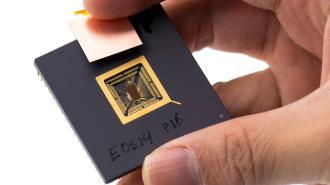This article is an installment of Future Explored, a weekly guide to world-changing technology. You can get stories like this one straight to your inbox every Thursday morning by subscribing here.
A new approach to designing computer chips is saving tech companies time and money, while also allowing them to equip their devices with chips that perfectly match their needs.
ISAs 101: Computer chips are essential to modern life. We need them for our phones, cars, computers, and an ever-growing number of other devices — and the still-lingering global chip shortage spurred by the pandemic shows how a dearth of them can have a ripple effect through the economy.
The reason chips are so important is they serve as the “brains” of our devices, processing and storing information that they get from software programs.
A chip’s “instruction set architecture” defines its supported commands and more.
To ensure a chip can understand these coded instructions, chip designers program in a basic “vocabulary” that might include commands like “add,” “compare,” or “store to memory.”
This vocabulary is the chip’s “instruction set,” and its “instruction set architecture” (ISA) defines its supported instruction set, how it receives commands, and more.
The two dominant ISAs are proprietary, so users have to spend money to access them.
The status quo: While anyone can invent a new ISA, two currently dominate the tech industry: Intel’s x86 and ARM Ltd’s ARM. The former is typically used for chips in computers, laptops, and servers, while the latter is more prevalent in chips for mobile devices.
The dominance of just a couple of ISAs means software developers don’t have to constantly rewrite code — a program designed for one ARM chip will be compatible with other ARM chips — but the downside to these popular ISAs is that they’re proprietary.
That means a startup that wants their in-development laptop to be able to run software written for x86 chips will need to either license the x86 IP from Intel and build their own chip or buy an off-the-shelf x86 chip made by Intel or another licensee.
In either case, they’ll be spending money for access to an ISA that might not even be exactly what they need for their device.
“As an open architecture, RISC-V offers much more flexibility, scalability, and extensibility.”
Calista Redmond
What’s new? In 2010, a new architecture, RISC-V (pronounced “risk five”), was developed at UC Berkeley, and unlike x86 or ARM, it’s an open standard, which means anyone can freely access it and contribute to its development.
This architecture is now finally transitioning from a novelty to a major player in the tech world, with RISC-V-based chips turning up in everything from laptops to autonomous car systems.
NASA plans to use a RISC-V-based CPU in the computers for its future space missions, and while there isn’t a RISC-V smartphone yet, Google is preparing for one — in December 2022, it announced that its Android OS will support the RISC-V ISA in addition to ARM and x86.
RISC-V International — the Switzerland-based nonprofit that coordinates RISC-V’s development and adoption — had just 235 members in February 2019, but today, it boasts more than 3,180, including many tech heavyweights, such as Google, Huawei, and Meta.
Intel itself has even joined the nonprofit and plans to use part of a new $1 billion foundry fund to support RISC-V development and adoption, presumably in the hope it’ll be the one to actually manufacture RISC-V chips for customers.
The better chip: The appeal of RISC-V extends beyond the fact that chip developers can access the architecture for free — it also has a modular setup that makes it easier to create chips that are optimized for certain functions without any unnecessary extras.
“As an open architecture, RISC-V offers much more flexibility, scalability, and extensibility compared to closed, proprietary ISAs,” Calista Redmond, CEO of RISC-V International, told Interesting Engineering.
“Since RISC-V is an extensible ISA, companies can easily implement the minimal instruction set and add on defined extensions and custom extensions to create custom processors for these new and innovative workloads,” she added.
“Our vision for 2022 was to bring RISC-V everywhere, and that has really come to fruition.”
Calista Redmond
As RISC-V International’s CTO Mark Himelstein told MIT Technology Review, this approach can save developers money and time. He cited the example of earbud maker Bluetrum, which used the open standard to build exactly what it needed.
“If they had not used RISC-V, either they would have had to buy a commercial chip with a lot more [capability] than they wanted, or they would have had to design their own chip or instruction set,” Himelstein explained. “They didn’t want either of those.”
The bottom line: The RISC-V ecosystem is quickly growing, and proponents expect to see the architecture used even more widely in the future.
“Our vision for 2022 was to bring RISC-V everywhere, and that has really come to fruition with RISC-V adoption and development in everything from automotive to aerospace to the data center, as well as consumer devices,” said Redmond.
“There are already billions of RISC-V cores in the market with this groundswell, and we expect to see billions more in 2023 as companies and countries around the world embrace RISC-V,” she continued.
We’d love to hear from you! If you have a comment about this article or if you have a tip for a future Freethink story, please email us at [email protected].





